How Do You Maximize Your Facebook Ad Campaign?
If you are a business owner who has a business page on Facebook.
Then you’ve probably heard about Facebook Ad Campaign (if you haven’t played yet!).
Facebook ads are content that your business page sponsors with advertising costs.
These ads appear in different parts of your target audience’s news feed.
Make your business appear in your already scrolling Facebook account.
In theory, it sounds like a dream to a company.
However, it only works if you have properly configured your Facebook advertising campaign. please do not worry. We’ll talk more about this later.
Facebook ads are also really cheap compared to older ads.
Classic-style advertising. You can reach thousands of people for just a few dollars.
What’s more, this new viewer can reach in a fun sociable environment with fun downtime …
… (What is it that looks away or catches from your favorite TV shows in commercials?
… a sign that stands in a traffic jam and just wants to go home).
There are many benefits to using Facebook’s advertising campaigns, but they need to be properly configured to be effective.
How Do You Create A Facebook Ad Campaign?
Therefore, before you start your first Facebook ad campaign, there are some factors that can help your Facebook ad campaign work effectively.
And in today’s blog, we’ll dig deeper into each of these points.
I often hear from new customers, “Facebook always suggests strengthening my posts.
But why didn’t it still bring me more sales?” Does it sound like you too?
Have you run an ad unsuccessfully in the past, or have you used Facebook ads for the first time?
Explains everything you need to know to configure a Facebook advertising campaign for more leads and sales.
Step-by-Step Method to Create A Facebook Ad Campaign
Step 1: Determine Your Objective
Before even creating a new campaign, first thing’s first: what are you looking for from your Facebook ad campaign?
Most people answer this question with sales or leads, but you’d be amazed at how many people are…
…running boosted posts (which optimize for post engagement) and complaining that they’re not seeing sales from it.
Now, don’t get us wrong; boosted posts and other ad types of Facebook brand awareness ad campaigns have their role to play…
…in your overall sales funnel. But you have to be looking at it from a big picture point of view.
If you’re looking for more direct results, you need to be strategic in which ad format and type of Facebook ad campaign that…
…you invest your ad dollars in we’ll discuss this in detail a little later.
For now, let’s talk more about Facebook ads and campaign objectives.
When we ask what results you’re looking for, we ask because it will help us determine what type of Facebook ad campaign you should be running.
Shown above are all the different types of Facebook advertising campaigns (or objectives) that you can run, each optimized for a different purpose.
For example, as part of an engagement campaign, boosted posts serve ads to the following locations …
… Facebook users in selected audiences who may interact with your ads (comments, likes) , Sharing, etc.).
The Video Viewing Campaign delivers ads to people in your target audience who are likely to watch video ads on their social networks.
Knowing this information can make a big difference in the type of advertising campaign you run.
If your business page (or officially known as Facebook Page Likes) requires Facebook followers.
Next, you need to run a Facebook Page Like ad on your engagement campaign.




Page Like ads are optimized for Page Like ads, so serve ads to people in your target audience …
… Make your page higher based on your Facebook action history and behavior. Those who are likely to evaluate. The big mistake many
clients make is to run a traffic campaign instead of a conversion campaign.
Both traffic and conversion campaigns are sending people to your website, but only one of them is optimized for sales and leads! The
traffic campaign will show your ad to the users who are most likely to click. The conversion campaign will show your ad to users who are more likely to click to convert.
In general, the cost per link click is higher for conversion campaigns than for traffic campaigns.
But I hope the clicks will be of higher quality and will generate more sales.
Another campaign we would like to point out is the App Install campaign.
If you have an app that wants to increase downloads (either on the App Store or Google Play), the app install campaign is your friend!
If your website only redirects to the App Store, promoting your website’s visitors is not efficient (and effective). You can also download the
app and send it directly to a location where you can track the number of app installs from there.
However, what I’d like to say about the app install campaign is that it requires a lot more setup work than other campaigns. The
app itself must meet Facebook requirements before it can be advertised on the platform …
… (This is an in-app change that developers need to make before setting up an ad campaign. May mean).
The last two campaigns I would like to emphasize are lead generation campaigns and messaging campaigns.
The Lead Generation Campaign delivers lead ads to people who are likely to fill out lead forms.
A lead form is a form that appears on Facebook after someone clicks on a lead-generating ad.


This form captures your potential customers’ information and saves it for you in your Facebook Ads Manager or Business Manager account.
Similarly, the Messages campaign also operates within Facebook and does not send users to your site or anywhere outside of Facebook.
It starts a Facebook Messenger conversation between the user and your Facebook business page.
The positive feature for both of these campaigns is that they both usually yield a higher response rate due to the ease.
And, convenience for users to respond.
The downside is that both campaigns can yield a lower quality lead as a result meaning the users are not as qualified…
…as they would have been had they gone to a website and scrolled to fill out a form.
Knowing the small but important pieces of information like this regarding Facebook ads can be crucial to choosing the right campaign and…
…running it effectively.
This is why many business owners hire us to handle their Facebook advertising for them.
Interested in advertising on Instagram, Pinterest, and/or LinkedIn? We specialize in that too!
So far we’ve talked about some of the more popular ad campaigns, but looking at the photo above.
You can get a good idea of all the different Facebook ad campaigns that you can run.
Overall, the results you’re looking for should reflect the campaign you invest in!
Step 2: Choose A Facebook Ad Campaign Strategy
Now that we know the different types of Facebook ad campaigns and their purposes, let’s talk about how to use them.
You’ve decided at this point what your goals are and what you’re trying to achieve with your Facebook ads;
Now you need to choose which strategy you want to follow to achieve it: short term, or long term.
Earlier we talked about how brand awareness ads like a boosted post can be useful if you’re looking at the bigger picture.
When we talk about the big picture, we mean the whole sales funnel from top to bottom (and this generally means following a long-term strategy).


A long-term strategy means warming up your audience over time.
Introduce them to your brand and build relationships with them on social media…
… (thus building trust with them in your business) Before asking them to buy or sign up directly To.
Here, boosted posts, page-like ads, video views, and other “lightweight” campaigns come into play.
These campaign action calls (CTA) are very easy for users to swallow.
Users don’t need to take serious steps to like your business page or watch your video (and it’s free for them).
The good news is when they take these little actions.
They officially stored your Facebook advertising account, so you can continue to display strategic and specific ads throughout your trip.
The overall idea of the long-term strategy is to take its audience from the infamous stage to the signing stage.
Because they have already spent months getting to know your brand.
If you see your company’s ads etc. and display the conversion ads directly on them, the cost per conversion should be relatively low.


The long-term strategy is generally more effective, and it’s what we always recommend for our new clients if they have the time and money to do it.
If not, then the short-term strategy may be the way to go. The short-term strategy basically skips steps 1-2 from the sales funnel pictured above.
With this strategy, you’re serving lead or conversion ads directly to a cold audience.
When we say a cold audience, we mean an audience that has never heard of your brand or business before;…
…they are brand new and have not been warmed up at all.
Either way, with the long-term strategy or the short-term strategy, when you get to steps 3, 4, and 5, the type of ads you’ll want to run tend to be similar.
As we mentioned earlier, a conversion campaign is what you want to run if you’re trying to track conversions on your website.
A conversion in this case can be a full-on sale (if you have eCommerce or appointment booking set up on your site for example).
Or it can be something like a contact us form (which would be considered a lead conversion).
Regardless, a lead magnet can be an effective tool to use in a conversion campaign to help increase click-through rate and close sales!
A lead magnet is an incentive that the user gets for completing the action you want them to complete.
A common lead magnet is a free eBook, coupon, or something downloadable that they can receive upon taking the desired action.
Giving customers a lead magnet can both assist you seize their facts to observe up with them each on Facebook and once more with e mail marketing.
Or, it is able to be some thing like a chit code that offers them the motivation to move beforehand and purchase.
The nature of your enterprise will decide in case you want to move after their touch facts or not.
For instance, in case your enterprise version entails a income member talking with the client with the intention to assist near them, then you`ll need to pursue leads.
But in case your enterprise is a web garb store, for example, you`re possibly searching greater for direct purchases.
Obviously, it doesn`t harm to have your audience`s touch facts both way.
But in case you`re tight for your advert price range and want to choose one campaign, then select the only this is going to make the maximum feel on your enterprise.
Step 3: Decide On Your Ad Budget (And What To Expect With Yours!)
Speaking of being tight on your ad budget, let’s talk about that a little bit. How much does all of this cost?
We talk about the cost of a Facebook ad campaign in another blog post on our site.
But we can go over some of the highlights here as well as it relates to structuring your Facebook ad campaign for success.
The Cost
The first thing you have to think about is which ad campaign you’re going to run. Some ad campaigns can function on $1.00 per day.
Whereas other campaigns have to have at least $5.00 a day to spend or else Facebook can’t run them.
Also, as we said earlier, different actions are easier for users to make on ads; for example.
It’s a lot easier for a user to like your business page for free than it is to have them pay for a $300 service.
Because of this, you’ll see that the cost per result varies in your different ad campaigns.
So depending on what type of action you’re going after, the cost per click (CPC) can be higher or lower than other ad campaigns.
You’ll also need to take into account who you’re targeting and where. In general, national campaigns tend to be less expensive than local campaigns.
For example, the average cost per page like when you’re targeting a local area is $1.00.
And, the average cost per page like when you’re targeting nationwide in the U.S. is about $0.50. This will also vary by country.
This same rule of thumb applies to all the Facebook ad campaigns too, not just the page like ad campaign.
So you’ll need to keep this in mind as you plan your ad budget out.
The Audience
Another factor to consider is who you’re targeting. Some audience targeting options on Facebook are more expensive than others.
For instance, ad targeting people with an upcoming birthday is popular with many advertisers so that they can offer them a “free gift” as a lead magnet.
The problem is that thousands of advertisers all have this same idea and are all trying to target the same audience at the same time.
Facebook then has to go through its process of deciding which ad to show out of the lot, and part of that has to do with…
…which advertiser is bidding the most money.
Therefore, popular audiences can become more expensive to advertise to than others.
The Placement
The last thing to consider (that many advertisers don’t!) is ad placement.
You may hear that and think, “What do you mean?… I thought we were placing it on Facebook?”
There are many different placement options within Facebook and Instagram (since Facebook owns Instagram).
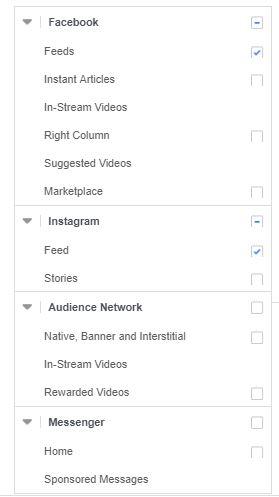

Pictured above are all the different types of placements you can serve your ad. Not all placements are available for every single campaign, but most are.
The key to choosing your ad placements is knowing which are effective and which are wasting your ad dollars.
For example, Facebook will always recommend running your ads on Audience Network.
But in actuality, Audience Network is known for capturing a slew of fake clicks.
Have you ever played a game when you clicked the start button on your mobile phone app?
Clicking pops up an ad, do I need to “click” on the ad? It’s essentially an audience network.
Do you want to waste your advertising costs on such placements? We don’t do that either.
If you don’t have a professional Facebook advertising agency like us to help you avoid these placements from the beginning.
You can also use the ad account placement breakdown to view the results of your ad.
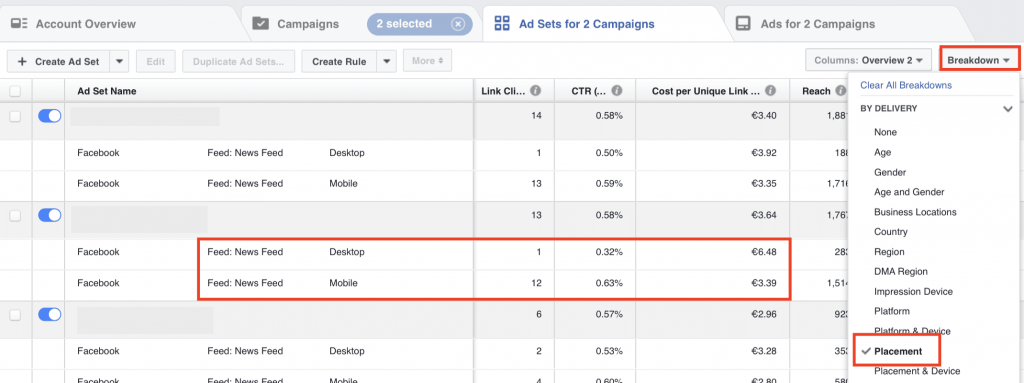

This can also tell you which placement your results are coming from.
Knowing this information will help tell you how and where to invest your ad dollars wisely.
Step 4: Make Ad Creatives
So far, we know what kind of campaign to run and how much to spend on it. Let’s talk about real-world advertising best practices in
Earlier we talked about the different types of goals you can run and your Facebook advertising campaigns.
Within these campaigns, the ads themselves, i. H. Text and subject.
There are different ad creations you can run, depending on the type of campaign you are running.
Otherwise, the ad text and text options for Facebook ads are usually the same for all campaigns.
The main difference is that headlines and headline descriptions are not available for some campaigns


The most basic creatives are image and video ads. There are only two main things to note here.
The first is that Facebook has a 20% text rule for all ad creatives.
This means that no more than 20% text can be on an ad image or a video ad thumbnail; if it does, the ad will not run at all.
Even if there is anywhere in between 1% and 20% text on the ad creative.
Facebook will intentionally serve your ads less than other advertisers trying to reach the same audience that may have less text on their creative.
This means you can put the same amount of ad dollars behind a creative with no text on it at all, and already be a little ahead of your competitors.
Recently, Facebook has announced the new ad restrictions for mobile.
And with these new sets of rules, everything went smaller.
Mobile ads now show three lines of text with a see more link. The photos and videos aspect ratio also decreased to 4:5.
The second thing to note is that you can easily advertise the same ads on Instagram since Facebook owns Instagram.
But Instagram can only show videos that are 1 minute long or shorter.
Keep this in mind as your planning out video creatives that you intend to run on both platforms.
Another innovative type of ad is the carousel ad. This is where you have several 600 × 600 ad images side by side that the user can swipe through.
You can either have them create one big single image ad.
Or you can have each ad be its own photo that links to the exact product on your site, like the ad below.
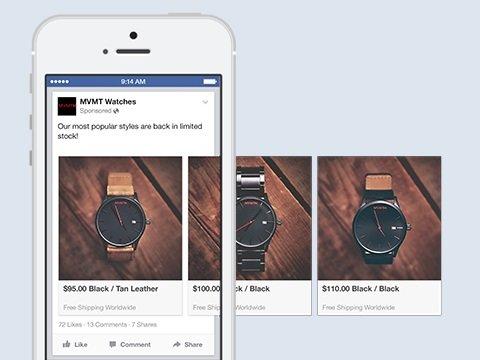

This ad, as well as slideshow ads, is typically good for businesses that have eCommerce on their site.
Even if users don’t click on the ad anywhere, you can still retarget them if they swipe through the pictures!
Speaking of retargeting, dynamic retargeting or remarketing ads are also really effective to use for eCommerce sites.
Retargeting in general just means showing the ad to a group of users who have already touched base with your brand or business in some way.
This could be Facebook engagement, an email list of people who have signed up for your newsletter, website traffic, etc.
What’s cool about dynamic retargeting is that you can show people the exact product that they searched for on your site.
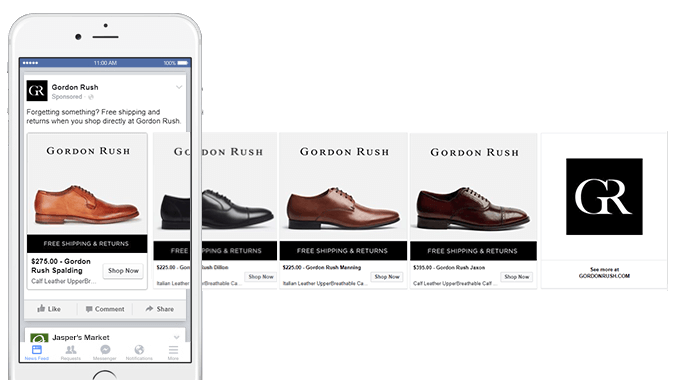

This can help close buyers that were on the fence initially by showing them the exact product that they were interested in!
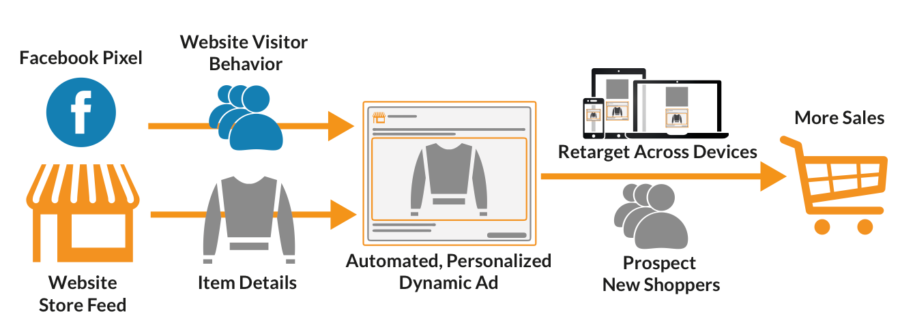

It works the same way as a carousel ad, but it just takes a little more setup since you have to link your product catalog to your Facebook ad account.
Step 5: Define Your Target Audience
So far, we’ve spent a lot of time talking about the makeup of a Facebook ad campaign and how to put all of your best practices forward.
So now, who are you showing these ads to?
Knowing who your target audience is key to conducting an effective campaign.
Following best practice with your Facebook ad campaign doesn’t matter if the people who are seeing the ads are totally…
…uninterested in your service or product!
So many advertisers are dumbfounded when they run a sale or deliver a coupon code and still don’t see results.
But incentives are to help push interested, relevant audiences to convert.
Think of it this way; if you’re selling dog food, you want to make sure you are delivering the ads to people who own a dog!
Cutting the price in half over and over isn’t going to help if the product isn’t relevant to the market.
Once you figure out exactly who your target audience is, then it’s time to determine how to find them on Facebook!
Custom Audience
One super useful tool that Facebook provides is the ability to create custom audiences.
You can upload your email list of customers or warm newsletter sign-ups and deliver specific ads to those audiences if they’re on Facebook…
…with the email address you have.
Lookalike Audience
Another custom audience we love to utilize for our clients all the time is a lookalike audience.
A lookalike audience is an audience that “looks like” the original list you upload based on similarities and patterns that Facebook sees.
This means if you have an email list of 1,000 customers, Facebook can take that list and find a brand new group of people…
…who “look like” your customer base! This can create a shortcut to finding out just who your target audience is on Facebook.
Audience Based on Engagement
Outside of custom audiences, you can also dissect your audiences.
We’ve touched on this a little here and there throughout this blog.
But you can create audiences of people who have watched your Facebook video ad for more than 10 seconds or of people who have engaged…
…with any post or ad.
This can help you set up ads that deliver to very specific retargeting audiences.


Finally, you can always target based on demographics, interests, and buying behavior.
Facebook has an extensive list of targeting options for all three categories, which are constantly changing and updating.
Additional Tip: Don’t forget to always A / B split test your campaigns, ad groups, and even landing pages.
Also, install Facebook Pixel on your website or landing page to help you measure, optimize, and build your ad campaign audience.
Conclusion
These are the best practices for a Facebook ad campaign! When you take the time to structure your Facebook ad campaign strategically.
It can become highly effective. Don’t have the time and want professionals to manage your Facebook ad campaign for you? Contact us today!

Pingback: Real Estate Facebook Ads: Ultimate Guide : Ankita Mankotia
Pingback: A/B Testing: 5 Effective Ways to Optimize FB Ads : Ankita Mankotia